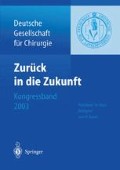Summary
Recent studies using split skin and CEAs in conjunction did not show satisfactory long-term results. The reason is a lack of a epidermal-dermal junction zone that frequently leads to weakness, epidermolysis and vesication of the transplants. In addition, hypertroph scarcontractions often cause problems in patients’ rehabilitation. The purpose of this study was to examine synthetic dermal substitutes (Polyactive, Collagen, Integra) in a standard pig model in order to identify substitutes suited for dermal substitutes and split skin grafts in full-thickness wounds.
Zusammenfassung
Bislang vorliegende Daten über bereits klinisch eingesetzte Ersatzstoffe wie Spalthaut und CEAs (kultivierte epidermale Sheet Grafts) weisen enttäuschende Langzeitergebnisse auf, da nach epifaszialer Nekrotomie und Transplantation von Spalthaut bzw. CEAs das Fehlen einer epidermal-dermalen Junktionszone häufig zur Instabilität mit Epidermolysen und Blasenbildung führt. Häufig kommen noch hypertrophe Narbenkontrakturen hinzu, die ein großes klinisches Problem in der Rehabilitation der Patienten darstellen. Ziel dieser Studie war es, neu entwickelte synthetische Gewebeersatzstoffe (Polyactive™, Collagen, Integra™) im Experiment am Tiermodell zu untersuchen, die sich als dermale Ersatzstoffe und für autologe Spalthauttransplantate auf Vollhautwunden eignen.
Access this chapter
Tax calculation will be finalised at checkout
Purchases are for personal use only
Preview
Unable to display preview. Download preview PDF.
Literatur
Shakespeare, P (2001) Burn wound healing and skin substitutes. Burns 27: p 517–522
Van Dorp AG et al. (1998) Dermal regeneration in full-thickness wounds in Yucatan miniature pigs using a biodegradable copolymer. Wound Repair Regen 6: p 556–568
Yannas IV et al. (1989) Synthesis and characterization of a model extracellular matrix that induces partial regeneration of adult mammalian skin. Proc Natl Acad Sci USA 86: p 933–937
Pieper JS et al. (2000) Development of tailor-made collagen-glycosaminoglycan matrices: EDC/NHS crosslinking, and ultrastructural aspects. Biomaterials 21:p 581 – 593
el Hadidy M et al. (1994) Contraction and growth of deep burn wounds covered by non-meshed and meshed split thickness skin grafts in humans. Burns 20: p 226–228
van Zuijlen PP et al. (2001) Dermal substitution in acute burns and reconstructive surgery: a subjective and objective long-term follow-up. Plast Reconstr Surg 108: p 1938–1946
van Zuijlen PP et al. (2000) Graft survival and effectiveness of dermal substitution in burns and reconstructive surgery in a one-stage grafting model. Plast Reconstr Surg 106: p 615–623
Burke JF et al. (1981) Successful use of a physiologically acceptable artificial skin in the treatment of extensive burn injury. Ann Surg 194: p 413–428
Stern R, McPherson M, Longaker MT (1990) Histologic study of artificial skin used in the treatment of full-thickness thermal injury. J Burn Care Rehabil 11:p7–13
Author information
Authors and Affiliations
Editor information
Editors and Affiliations
Rights and permissions
Copyright information
© 2003 Springer-Verlag Berlin Heidelberg
About this paper
Cite this paper
May, P., Drücke, D., Lamme, E., Hermann, S., Steinau, H.U., Steinstraesser, L. (2003). Dermisersatzstoffe in porcinen Vollhautwunden. In: Bauer, H. (eds) Zurück in die Zukunft. Deutsche Gesellschaft für Chirurgie, vol 2003. Springer, Berlin, Heidelberg. https://doi.org/10.1007/978-3-642-55611-1_44
Download citation
DOI: https://doi.org/10.1007/978-3-642-55611-1_44
Publisher Name: Springer, Berlin, Heidelberg
Print ISBN: 978-3-540-20002-4
Online ISBN: 978-3-642-55611-1
eBook Packages: Springer Book Archive

